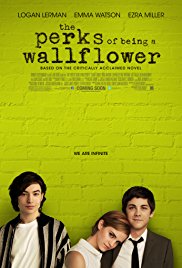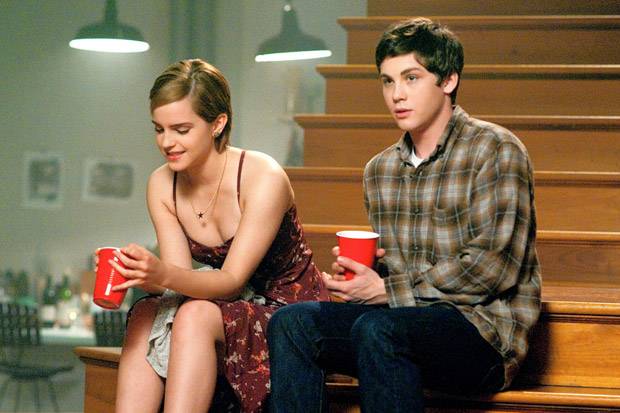8. Why didn’t Charlie ever ask Sam out on a date?
Suggested Response:
He was going to and then Mary Elizabeth happened. After Mary Elizabeth, he was probably too scared.
9. Stephen Chbosky, the author of the book who also directed the film, has described one of the life-lessons of the film in the following way. What do you think about this statement:
If you just reach out and you present yourself exactly as you are, the right people are going to say yes to you and the right people are going to befriend you and the right people are going to accept you and you can make great friends forever.
Suggested Response:
There is no one correct answer. Some students will agree and some will disagree. The purpose of the question is to get students thinking about the question.
10. Sam said that she thought that one day, “I’d see a person across the room and I’d know everything was ok.” What type of thinking does this demonstrate?
Suggested Response:
There is no one correct response. One strong response is that this thought is an example of magical thinking. Another is that the thought is an example of romanticism. The basic concept is that it’s not realistic. Good relationships are made by loving partners who do whatever work is necessary to make the relationship strong.
11. How would you describe Charlie’s family and its affect on Charlie?
Suggested Response:
Adjectives that could be used are close, loving, concerned, supportive, helpful, and life-saving. Some students might describe the family as blind or unable to observe because they didn’t notice what Helen was doing to Charlie. This is unfortunately true of many situations in which children are abused.
12. Describe some of the evidence of Charlie suffering from some type of mental illness.
Suggested Response:
There are many, but here are a few: seeing disturbing images in his mind; uncontrollable rage when someone is going to hurt a friend (this rage was so strong that he beat up three seniors); obsessiveness, as when he is calling everyone after the break-up with Mary Elizabeth; blackouts; crying, suicidal thoughts. Also, the audience sees Charlie taking medication.
13. What does Charlie mean when he says that he feels infinite?
Suggested Response:
He is accepted by his friends and this connection makes everything right with the world.
14. What is the moment in this story when Charlie gets a chance to become a hero? Why did you select this occasion?
Suggested Response:
There are many answers to this question. The justifications for the choice should refer to themes of the story. The author/director chose the night at the football game when Charlie went to sit near Patrick in the hopes of striking up a conversation.
15. Had Charlie gone to the football game and not changed his seat to be near Patrick, what would have happened?
Suggested Response:
There is no one correct answer. Good responses will include: there would have been no story; he never would have met Patrick or Sam; he would have stayed friendless for a while longer. Mr. Chbosky put it this way, “He could have stayed in his seat for the next three hours and hate the fact that he would never get up.”
16. Why was Charlie contemplating suicide?
Suggested Response:
There is no one correct answer. The best answers will refer to the themes of the story. One good answer is that the repressed memories of what his Aunt Helen had done to him were coming to the surface and they were so painful that he could not bear them. In addition, all his friends were leaving school and going off to college; he was facing the next two or three years alone and while this was not enough for suicide, it was a contributing factor.
17. Who or what are the antagonists in this story?
Suggested Response:
There are several. For Charlie, they include Charlie’s isolation; the adolescent culture which allows kids to be shunned, insulted and bullied; the effects of the injury that Charlie suffered at the hands of Aunt Helen. For Patrick, the antagonist is the prejudice against gays. For Sam, the antagonist is her lack of self-esteem.
18. Who or what are the protagonists of this story and what are they seeking?
Suggested Response:
Charlie is the chief protagonist, but there are at least two others. Charlie is seeking acceptance and friendship, love, and to recover from the injuries caused to him by Aunt Helen and by Michael’s suicide. Patrick is seeking to recover from the loss of his relationship with Brad, specifically, and generally, he confronts prejudice against gays. Sam is seeking love and to redeem herself after her first disastrous years in high school.
19. In the fight between Candace and her boyfriend, what did she do to provoke him? Is this question of any importance in determining the blame for this incident?
Suggested Response:
She insulted him and then she hit him on the chest ineffectually, doing absolutely no harm. She kept at him after he asked her to stop. That is no excuse for Pony Tail Derek’s action in hitting Candace. Boys should never hit girls; men should never hit women. For that matter, women shouldn’t hit men but due to the fact that the average male is much stronger than the average female, it’s orders of magnitude worse for a man or a boy to hit a woman or a girl.
20. John Malkovich, a well-known actor who was a producer of this movie, said that in a movie, “when you have heart you don’t need sentiment.” What did he mean by that? Give an example from the film.
Suggested Response:
The basic concept is that when the story evokes feelings that flow from the heart of the audience, the actors and the filmmakers don’t have to work at showing the sentiment; understated presentations (acting, music, lighting etc.) will work much better. The imagination of the audience supplies the emotion. One example is when Charlie is telling Sam about Michael’s suicide.
21. People have a tendency to repeat flawed relationships. Does that apply to the relationship between Charlie and Sam? Explain your reasoning.
Suggested Response:
The following is a theory and there are counter-arguments that students may come up with: Sam is an older nurturing female, as Aunt Helen was older and claimed to be nurturing. Sam gives Charlie what she thought was his first kiss in order that it be given by someone who loved him. She gave him a typewriter and an instruction to write, to assist him in developing his talents as a writer. Charlie describes Aunt Helen as his best friend until he met Sam. There is definitely an element of repetition in Charlie’s relationship with Sam, but it is also common for young boys to have strong feelings for older girls. The obvious difference between the two relationships is that because Charlie is older now and because of his relative closeness in age with Sam, the relationship with Sam is not tainted with sexual abuse. That makes all the difference. Note, however, that if Sam had been over 18, in many jurisdictions, she could have been prosecuted for child sexual abuse of Charlie who was probably 15 or 16. Prosecutions based on this type of age difference have been known to occur on rare occasions.
22. In the cafeteria, why did Charlie become so enraged that he could beat three senior football players and then not remember what he did?
Suggested Response:
Any well-reasoned answer will suffice. Here is one possible answer: Charlie had been so hurt by his Aunt Helen and he loved Patrick so much that he couldn’t bear Patrick being hurt. The reason that this incident is tied to the abuse that Charlie had suffered is that he blacked out. The fact that Charlie was defending his friend was no reason for him to black out. However, at that point, his mind was repressing everything that related to the sexual abuse. Seeing Patrick attacked brought that issue up for him and since it was too close to the surface his mind repressed the memory.
23. This film has an expository phase. Where does it end and what do we know by the time that occurs?
Suggested Response:
It ends at the end of the first letter, where we see the words, “Love, Charlie”. What we know includes something about Charlie’s background, about his supportive family, Charlie’s hopes for the school year, and his isolation at school.
24. After the “truth or dare” debacle, Charlie has lost the acceptance of the group, most importantly Patrick and Sam didn’t want to see him. He panics and calls people frequently. He tells Mary Elizabeth that “I get so messed up inside like I’m not there.” What is Charlie experiencing? Describe it.
Suggested Response:
Dissociation, which is detachment from immediate surroundings. A severe form involves detachment from physical and emotional experience.
25. Most seniors in high school won’t even talk to a freshman. Why did Patrick, Sam, and Mary Elizabeth, all of whom were seniors, allow Charlie into their circle of friends?
Suggested Response:
A good discussion will mention the following two points. First, these were just really nice and compassionate kids. The toast in which Patrick formally welcomes Charlie into their circle of friends, occurred right after Sam told Patrick about the suicide of Charlie’s best friend and that she didn’t think Charlie had any friends. The second reason was that these seniors were very low in the social pecking order of the school. Patrick refers to their parties as “The Island of the Misfit Toys”. Seniors with higher social standing would probably have been afraid that they would lower their position in school society by associating with a freshman, especially one who had been in a mental hospital the year before.
26. For each of the items of dialog below, describe its role in the development of plot or characterization or its relation to the theme.
Suggested Response:
You can’t just sit there and put everyone elses’ life ahead of yours and call it love.
This one moment when you know you are not a sad story and you’re alive.
Charlie: My aunt had that same thing done to her two and she turned her life around.
Sam:She must have been great. Charlie: She was my favorite person in the world until now.
I don’t know if I’ll have time to write another letter, I’ll be too busy participating.
In this moment I saw we are infinite . .
The weird kid who spent time in the hospital . . .
27. What was the significance of Charlie giving Sam the books? What was the significance of Charlie giving Sam the typewriter?
Suggested Response:
Charlie gave Sam the books that had been important to him to give her part of himself. Sam gave Charlie a typewriter to encourage hhim to become self-realized.




